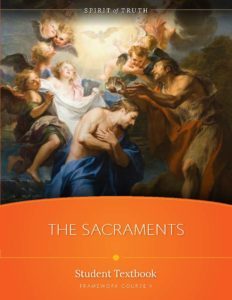
Overview
In this course students will discover how Christ is present to us in and through the Sacraments of the Church, especially in the Eucharist, which is Christ’s Body and Blood, Soul and Divinity.
- Spirit of Truth, High School Course 5 Teacher’s Guide
- Spirit of Truth, High School Course 5 Student Textbook
- Spirit of Truth, High School Course 5 Student Workbook
- Glossary
- Final Exam
- Final Exam Answer Key
- Final Exam Study Guide
- Final Exam Essay Form A
- Final Exam Essay Form B
- Final Exam Essay Form C
Units
Jesus established His Church here on Earth to continue His mission of the salvation of all souls. The Church is a visible sign of the invisible Kingdom of God, inaugurated by Christ during His earthly life. The Church uses visible signs and symbols to make known the invisible truths of our salvation. Jesus gave us the Seven Sacraments as visible, material means of receiving the invisible grace of God. How beautiful it is that God’s grand design for His creation and for our salvation is made known to us still today through the work of Christ’s Church. Baptism is the Sacrament of regeneration through water in the Word. By this first of Sacraments, we are made members of Christ’s Church and cleansed of all sin, receiving a portion of the Holy Spirit in our lives. The Sacrament of Confirmation is often misunderstood, despite the rich history of the Sacrament that reaches back to Jesus and the Apostles and its deep roots in the Old Testament. Contrary to popular belief, it is not a graduation ceremony or the Catholic equivalent of a Jewish bar mitzvah. Rather, the Sacrament of Confirmation is an important step on the path of Christian initiation that completes, or confirms, the outpouring of the Holy Spirit received at Baptism and sends the person out to proclaim boldly the Good News. The Eucharist is the source and summit of our shared Catholic faith. St. Thomas Aquinas says the Eucharist is “the consummation of the spiritual life, and the end of all the sacraments.” The Angelic Doctor intended that the words “consummation” and “end” be understood in their most Catholic sense as the fulfillment of the teleological purpose—that is, the thing to which all else points. We will all encounter the consequences of sin: the suffering and sickness that are a part of the human condition. And we will all face death. This Jesus knew and experienced Himself. In fact, Jesus closely identified with the sick and suffering not only during His own Passion but also during His public ministry, when He healed so many who were sick and infirm. Jesus sent His Apostles out two by two to heal the sick and forgive sins as a sign of the arrival of the Kingdom of God, prophesied from the Old Testament. The Sacraments at the service of Communion are those that Christ instituted for the service of God’s people and the entire human family. The first is the Sacrament of Holy Orders, by which the Church ordains men to serve as bishops, priests, or deacons. The second is Holy Matrimony, which calls a man and woman to the vocation of marriage and family life.

